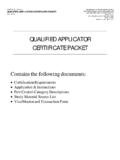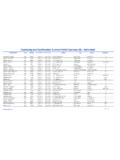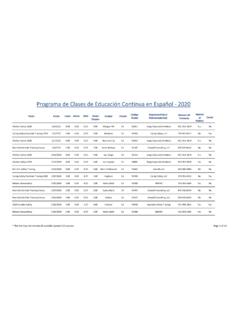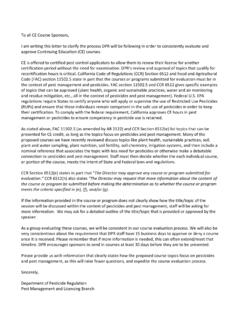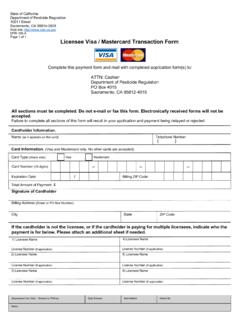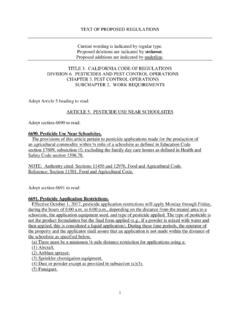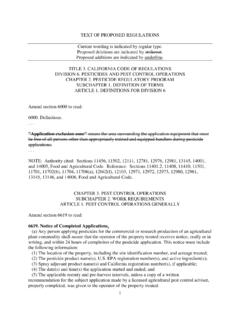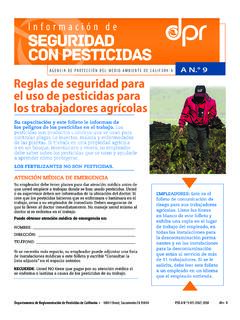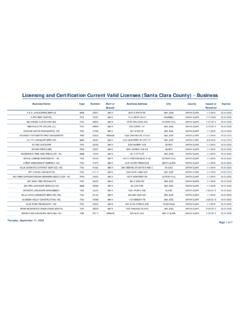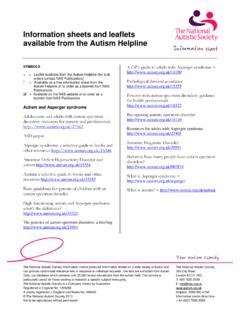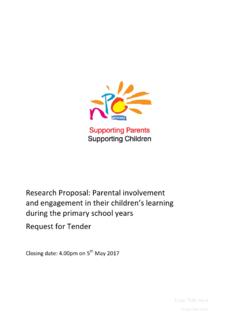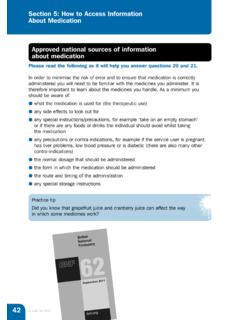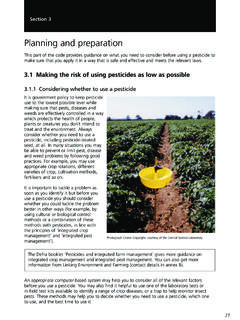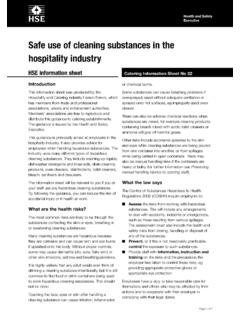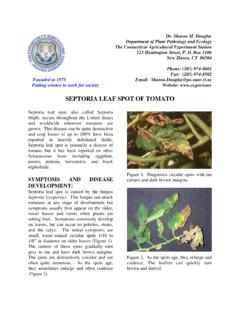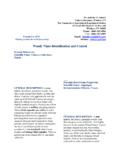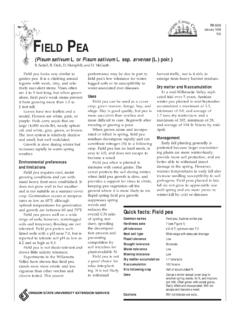Transcription of Entire Pesticide Safety Information Series - cdpr.ca.gov
1 CA Department of Pesticide Regulation l 1001 I Street, Sacramento CA 95814 HS-641A Revised 9/2015 INDEXP esticide SafetyINDEXI nformationCALIFORNIA ENVIRONMENTAL PROTECTION AGENCYPESTICIDE Safety Information Series (PSIS) A Series AGRICULTURAL SETTINGS Title FILE # REVISED Working Safely With Pesticides on Farms HS-002 PSIS A-1 9/15 Also available in Punjabi Translation (p) and Spanish (s) -002(p), -002(s)Storing, Moving, and Disposing of Pesticides on Farms HS-711 PSIS A-2 9/15 Also available in Punjabi Translation (p) and Spanish (s) -711(p), -711(s)Closed Systems, Enclosed Cabs, and Water-Soluble Packaging on Farms HS-713 PSIS A-3 9/15 Also available in Punjabi Translation (p) and Spanish (s) -713(p), -713(s)First Aid HS-716 PSIS A-4 9/15 Also available in Punjabi Translation (p) and Spanish (s) -716(p), -716(s)Protecting Yourself From Breathing Pesticides on Farms HS-632 PSIS A-5 9/15 Also available in Punjabi Translation (p) and Spanish (s) -632(p), -632(s) Safety Rules for Minimal Exposure Pesticides (MEPs)
2 On Farms HS-1697 PSIS A-6 9/15 Also available in Punjabi Translation (p) and Spanish (s) -1697(p), -1697(s)Washing Pesticide Work Clothing HS-1228 PSIS A-7 9/15 Also available in Punjabi Translation (p) and Spanish (s) -1228(p), -1228(s) Safety Rules for Pesticide Handlers on Farms HS-1571 PSIS A-8 9/15 Also available in Punjabi Translation (p) and Spanish (s) -1571(p), -1571(s) Pesticide Safety Rules For Farmworkers HS-1587 PSIS A-9 9/15 Also available in Punjabi Translation (p) and Spanish (s) -1587(p), -1587(s)Rules for Medical Care When Handlers Use Organophosphates and Carbamates HS-8 PSIS A-10 9/15 Also available in Punjabi Translation (p) and Spanish (s) -8(p), -8(s) CA Department of Pesticide Regulation l 1001 I Street, Sacramento CA 95814 PSIS A No.
3 1 (HS-002) A1 l 1 Why should I worry about pesticides?Pesticides can get into your body many different ways and can have both acute and chronic effects on your health. If a Pesticide can hurt you or make you sick right away, that is an acute health effect. If you have to be exposed to a Pesticide for a long time (months or years) before it makes you sick, that s called a chronic health effect. Pesticides can make you sick by moving into your body through your skin, mouth, eyes, or your lungs as you breathe. What can a Pesticide label tell me?Most labels have a special word in capital letters on the front of the label.
4 It tells you what the acute health hazard words you might see are: DANGER, this Pesticide is extremely harmful. WARNING, this Pesticide is moderately harmful. CAUTION, this Pesticide is slightly harmful, but still can make you the label doesn t have one of these words, it means that the Pesticide is less likely to harm you. However, you should handle every Pesticide must use pesticides according to the directions on the label. If you can t read the label, ask your employer to tell you what it says. For some pesticides, California has stricter rules than those on the label. Your employer must know these rules and tell you about Safely with Pesticides on FarmsWorkers who handle pesticides must be trained how to protect themselves.
5 Handle means to mix, load, or apply pesticides; repair or clean equipment that was used for pesticides; or touch unrinsed pes-ticide containers. The Information in this leaflet will help teach you about working safely with pesticides. Pesticide SafetyA No. 1 InformationCALIFORNIA ENVIRONMENTAL PROTECTION AGENCYKEEPING PESTICIDES OFF YOUR hands is often the hardest part of working safely with pesticides. Always wash your hands before eating, drinking, smoking or going to the bathroom. Safety TIP1CA Department of Pesticide Regulation l 1001 I Street, Sacramento CA 95814 A1 l 2 What Safety rules do I need to follow?
6 1. Read the labelRead the label, and then look at the application situation for things like weather conditions, people, or buildings around you. In hot weather, with no wind, it can be dangerous to apply pesticides because pesticides can stay in the air. However, too much wind can make pesticides drift onto people and make them sick, or onto other crops and cause damage. Look at these conditions and decide if it s safe before you apply a Pesticide . If you don t think it s safe, talk to your Be especially careful with pesticides before they are mixed with waterMoving Pesticide containers before the Pesticide is mixed with water, and hand-pouring pesticides from their containers, are the most dangerous parts of working with pesticides.
7 Pesticides that are mixed with water and are in the application equipment may be less dangerous, but can still hurt you. When working with these, or any pesticides, you should always try to avoid getting Pesticide on Wear the Right Kind of ProtectionProtecting your EYES: You must wear eye protection when you mix, load, or apply pesticides; clean or repair equipment; or flag for an aerial application. Types of eye protection can be Safety glasses (with temple and brow protection), goggles, a face shield, or a full-face mask. Pilots can use a visor for eye protection. Regular eyeglasses and sunglasses DO NOT provide enough protection.
8 Pesticides can easily get around these glasses and into your eyes. The Pesticide label will tell you what type of eye protection to your HANDS:Keeping pesticides off your hands is often the hardest part of working safely with pesticides. Once a Pesticide gets on your hands, it can get in your eyes if you rub them, or in your mouth if you touch your food. Always wash your hands before eating, drinking, smoking or going to the bathroom. You must wear gloves when you mix, load, or apply pesticides; clean or repair Pesticide application equipment; during all hand applications of pesticides; and anytime the label says so.
9 If the label does not say what type of glove you need, you must use gloves made of chemical-resistant material like rubber or neoprene. Never wear fabric-lined or leather gloves unless the label specifically says you may. Your employer must give you clean or new gloves every day you mix or load pesticides, repair or clean Pesticide equipment, or apply pesticides with hand-held equipment and you must wear them. In a few cases, a Pesticide label may tell you not to wear gloves. If it does, do not wear Department of Pesticide Regulation l 1001 I Street, Sacramento CA 95814 A1 l 3 Protecting your LUNGS: You must wear a respirator while using pesticides that are harmful if you breathe them (this can include fumigants, powders, dusts, and some liquids), anytime the Pesticide label requires one, or if you are mixing, loading or applying most pesticides on California s list of Mini-mal Exposure Pesticides.
10 Ask your employer for a copy of the A-6 Safety leaflet for more Information on Minimal Exposure Pesticides and for a copy of the A-5 Safety leaflet for more Information about your BODY: Your employer must give you clean coveralls (or a long-sleeved shirt and long pants) every day that you work with pesticides with either the word DANGER or WARNING on the label. Your employer must give you clean chemical-resistant clothes and equipment (such as a suit that covers your body, an apron, foot and head protection) if the label, or other rules, calls for them. If it is hot outside, wearing a chemical-resistant suit that covers your body may make you so hot that you can get sick.
